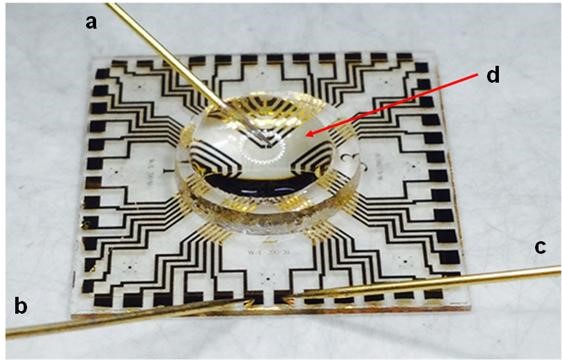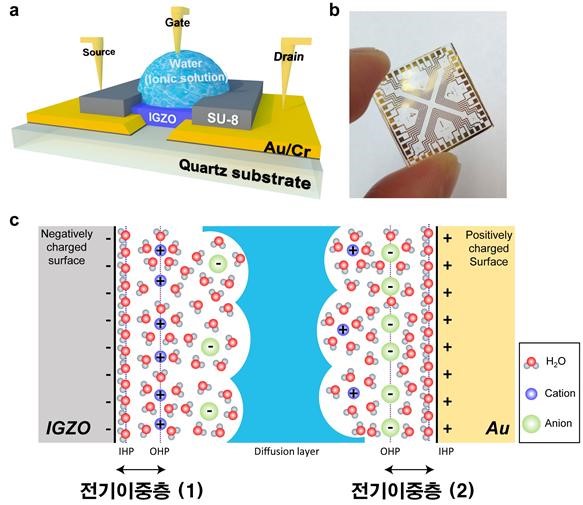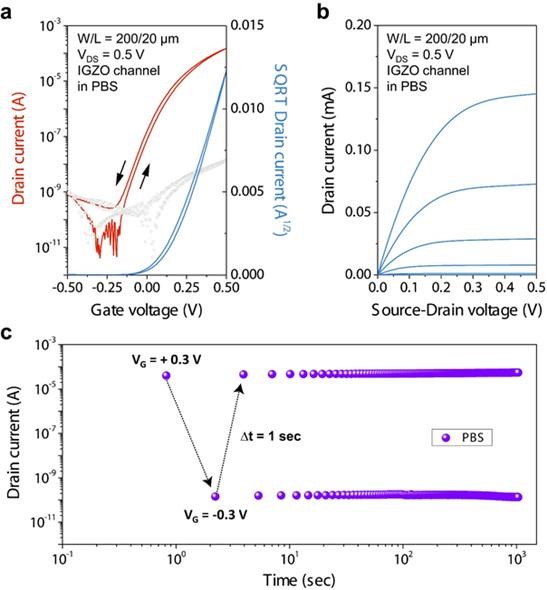Media Center
A multimedia mosaic of moments at GIST
GIST Excellence
[Press Release] A team led by Professor Myung-Han Yoon develops new core technology for human-implantable electronic devices
- 엘리스 리
- REG_DATE : 2015.08.20
- HIT : 950
Development of new core technology for human-implantable electronic devices

Figure1. Electrolyte-gated indium-gallium-zinc-oxide thin film transistor (IGZO-EGTFT) device array on a quartz substrate. (a) A gold gate electrode tip is inserted to form an electrical field in the phosphate buffered saline (PBS) solution. (b) (c) Metal tips were attached to source/drain electrodes to measure electrical current flow. (d) A donut-shaped transparent rubber ring traps the PBS solution.
□ Korean researchers have developed core technology for new electronic devices that are stable and can operate under water with ultra-low voltage. This is expected to contribute to the development of human-implantable bionics and biochemical sensors.
This research was led by Professor Myung-Han Yoon of the School of Materials Science and Engineering and performed by a Ph.D candidate Sung Jun Park. The research was supported by the Basic Science Research Program through the National Research Foundation of Korea (NRF) that is funded by the Ministry of Science, ICT & Future Planning and by the Center for Advanced Soft-Electronics that is funded by the Ministry of Science, ICT & Future Planning as a Global Frontier Project. The paper was submitted on August 14, 2015, to the online version of the Scientific Reports under the title “Sub-0.5 V Highly Stable Aqueous Salt Gated Metal Oxide Electronics.”
□ Technology related to implantable electronics has been in the spotlight recently for the diagnosis or diseases or for therapeutic purposes, but most such devices are difficult to commercialize because electronics tend to degrade in vivo when in the presence of electrolyte containing ions or because of high voltage.

Figure 2. Electrolyte-gated IGZO thin film transistors (IGZO-EGTFTs) using various aqueous dielectrics. (a) A schematic of aqueous salt EGTFT structure composed of a quartz substrate, source and drain Au/Cr electrode patterns, an IGZO semiconducting layer, an SU-8 passivation well for electrical isolation and solution reservoir containing pure water or salt solutions as dielectric. (b) A photographic image of completed IGZO-EGTFT device arrays on a quartz substrate. (c) An illustration of electrical double layers (EDLs) formed at IGZO and Au surface interfacing with an aqueous salt solution. The negatively (positively) charged surface exhibits an inner Helmholtz plane (IHP) of compact water layer and an outer Helmholtz plane (OHP) of diffusive hydrated cation (anions) layer.
□ The team took a traditional, low-cost metal oxide solution processing manufacturing method and developed a new transparent semiconductor composition that is insoluble in aqueous solutions and operates longer without water electrolysis.
An EDL is analogous to a conventional two parallel-plate capacitor where highly-dense surface charges on solid electrode and oppositely-charged ions in liquid electrolyte are aligned at the phase interface with angstrom-scale spacing, which is a very small unit of length, 10-10 m, and is approximately the size of an atom and is often used to measure the wavelength of electromagnetic radiation or distances between atoms. This feature underlines efficient carrier accumulation at the active channel as well as a low-voltage operation in a variety of EGTFTs.

Figure 3. Electrical characteristics of IGZO-EGTFTs operated in a PBS solution. (a) Representative bidirectional sweep of transfer curves (red), square-root of channel current (blue), and gate leakage current (gray) at VD = +0.5 V. (b) output curves at different gate biases (0 to +0.5 V with a 0.1 V step). (c) Drain current versus time (log scales) measured at every 1s with alternating gate biases of +0.3 and −0.3 V and a constant drain bias of +0.5 V of over 103 cycles.

The team demonstrated a very stable, high-performance electrolyte-gated thin-film transistors using sol-gel amorphous IGZO semiconductor and aqueous salt dielectrics (KCl, NaCl, KBr ions in water, and PBS solution) showing sub-0.5 V operation, high on-off current ratio, excellent transconductance, and clear pinch-off behavior. The researchers expect that--with such an excellent electrical performance and long-term operational stability (up to 8 hrs) of the aqueous IGZO EGTFTs--the technology may contribute significantly to the development of human-implantable bio-electronics, such as reusable in vivo biochemical sensors and implantable bionics.